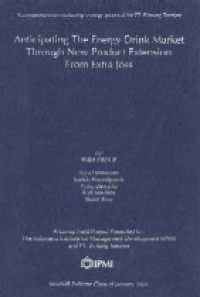
A Marketing Plan Review of Hyundai ATOZ
| Gmd : Text
| Availability :
| 00000010250 | 300 | (GFP) | Available - Ada |
Introduction to the Automotive Industry
Indonesian automotive industry is a significant industry but generally inefficient owing to highly distorted policy regime in the past. Nevertheless, the industry recorded some progress as indicated by growth and an increase in technological capacities. Prior to the crisis, automotive industry recorded tremendous growth. During the period of 1994 to1997, this sector experienced 20 percent growth rate on average. It reached 7.1. Trillion Rupiah in investment and employs 70.000 workers. Production of automotive in 1997 reached 390.000 units.
The crisis has exacerbated the inefficiency problem within the industry. While the industry facing the inefficiency problem, the global trend may intensify competition within domestic market as well as global market. However, the fact that Indonesia lies in emerging market with domestic demand rapidly expanding implies that there is still an opportunity for developing the industry.
Important factors in determining the organizational structure of an industry are the size of the output market (demand constraint) and the optimum scale of production (supply constraint). The automotive industry shares these general industrial organizational features. Take the supply constraint first. The first industrial organizational feature is that the efficiency of an industry depends largely on the ability of an industry to achieve economies of scale in production. However, since production process of a commodity consists of several activities, optimum size of production also varies across type of activities. For example, production of a car involves the following activities: assembly, machine shop, forging shop, casting shop, and press shop.
The second feature of the automotive industry derived from the economies of scale and sophistication of technology. Capital intensity increases as the minimum level of output increases and technology becomes more complex. The amount of investment required for an efficient assembly operation is definitely lower than that of full manufacturing. The third important feature that deserves attention is related to the size of the market.
When the market is small and the production process with large economies of scale, vertical integration of several stage of production process may be the best solution. As the market expands, however, specialization not only becomes feasible but also leads to greater economic efficiency. This might explain the prevalence of in house investment in Indonesia's automotive industry recently. In any case, whether it is a vertical integration or a network of component makers, primary firm requires efficient component makers (or an efficient in house component maker) given the demand constraint.
The fourth feature is related to the demand side. The demand for automotive industry can be divided into low price cars and luxury cars. The low price car is characterized by high income elasticity, while the luxury cars is characterized by low income elasticity. This seem to be a contradiction. However, the contradiction disappears if we envisage that the market was divided into two income groups. Low/middle income group considers low price cars as luxury items, while high income group considers luxury cars as necessary items. Since in the developing countries, the car buyers are mostly low/middle income earners, the automotive industry is very sensitive to the growth of real income. Finally, automotive industry is often considered as a national pride, therefore it attracts government intervention to build the automotive industry as a show case industry.
Research Location : PT Hyundai Mobil Indonesia
Supervisor : Satya Heragandhi, MBA
Accepted Date : 01 October 2005
Read at Library Only.
| Series Title |
-
|
|---|---|
| Call Number |
300
|
| Publisher Place | Jakarta |
| Collation |
80p.: tabs.figs.; 30cm.
|
| Language |
English
|
| ISBN/ISSN |
-
|
| Classification |
-
|
| Media Type |
-
|
|---|---|
| Carrier Type |
-
|
| Edition |
-
|
| Subject(s) | |
| Specific Info |
-
|
| Statement |
-
|
| Content Type |
-
|
No other version available







